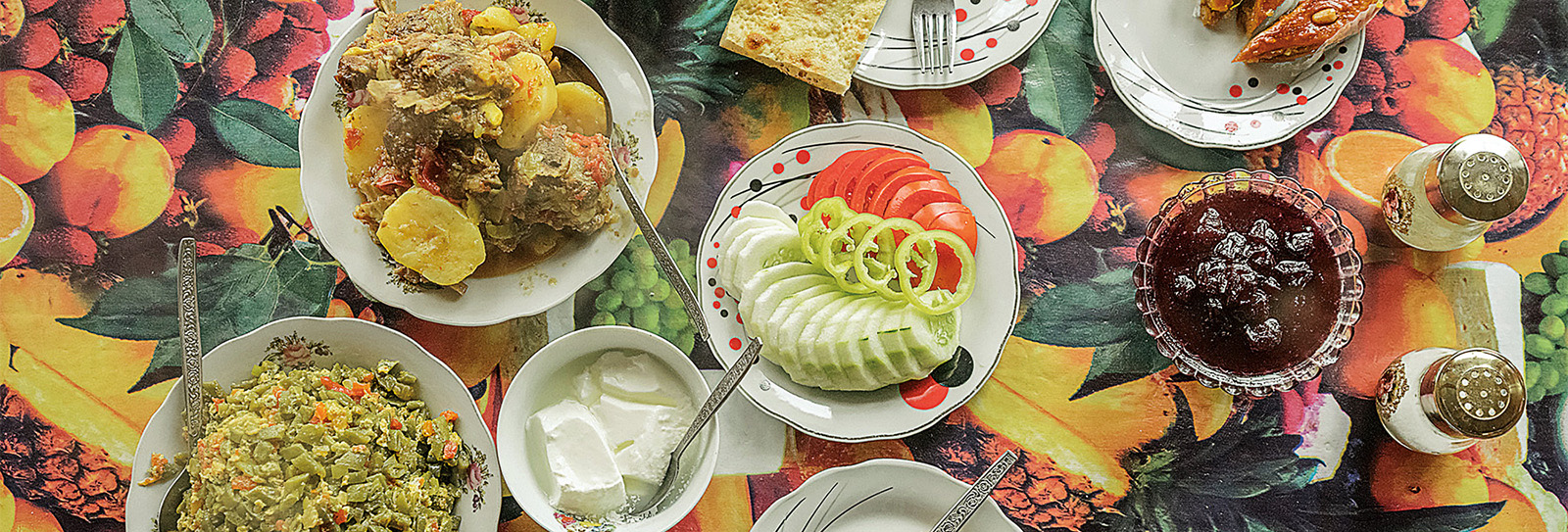
From Pilaf to Meat Pie: The Blended Influences of Azerbaijan Food
Azerbaijan has sat at a crossroads of Eastern Europe, the Middle East and Western Asia for centuries as a Silk Road hub and a gateway that empires routinely fought to control. That intersection also has manifested itself in the nation’s food—a complex and enticing stew of Turkic, Persian, Eastern European and other regional influences. This food diary explores the unique cuisines of each region.

This is Baku.

Situated on the ancient trade road from Central Asia to Europe, the capital of Azerbaijan is where history and cuisine collide.
The country has sat at a crossroads of Eastern Europe, the Middle East and western Asia for centuries as a Silk Road hub and a gateway that dynasties and empires routinely fought to control.
The resulting Turkic, Anatolian, Persian and Eastern European influences, paired with the reality of Azerbaijan’s diverse array of produce and other ingredients, have combined to create a complex and enticing cuisine.
Each region of Azerbaijan has a unique take on its cuisine, which I came to explore.

My first stop was the Baku suburbs, where half of Azerbaijan’s 10 million inhabitants live. Set amid boxy apartments built when the country was part of the Soviet Union, the Honey Cake Pastry School is educating a new breed of foodies. The graduates will go on to work in Baku’s thriving restaurant scene. Most speak fluent English, although their parents used Russian as a second language. To be part of Azerbaijan’s culinary scene, English is the only language to learn.

The star tutor at the cookery school is Elmira Gadirova, 62. In 2016 she started her own YouTube channel when she was looking for a distraction after losing a close family member. Gadirova’s videos on YouTube and Instagram soon found an audience for her style of Azerbaijani food. Her recipes like turşu (cucumber pickles) or shorgoghal (turmeric pastries) are classic dishes that she learned from her mother decades ago. Gadirova’s recipe for Bakı paxlavası—Baku-style baklava—alone has received more than 3 million views. She thinks she knows the reason.
“Some mothers-in-law keep their recipes a secret,” she told me, like a touch of orange juice here or a splash of rosewater there. “Instead, I share everything.”
Back on Baku’s Bulvar Boulevard, a promenade that runs along the seafront, Gani Nasirov, a professional culinary tour guide, said Gadirova’s traditional style of cooking is only a fraction of the big flavors that compose the distinctive cuisine of Azerbaijan. But her popularity is a sign of growing interest in Azerbaijan’s culinary traditions, Nasirov said, as he prepared to lead me across the city. “People want to know more about our food! There’s nothing else like it,” he said. “We’re even starting to see tourists from our own country and from other countries coming here to find out what it’s all about.”
“Some mothers-in-law keep their recipes a secret. ... Instead, I share everything.”
—Elmira Gadirova
Baku
With Nasirov as my guide, I began my tour of Baku with a stroll through Yaşıl Bazar (Green Market), a covered farmers market packed with produce from across Azerbaijan.
As we moved through the aisles, we passed piles of artfully arranged apples grown in the country’s mountainous north, bins of scarlet tomatoes that arrive daily from the subtropical south, and vats of olives and clusters of grapes from Baku’s hinterland. Mulberry trees line the streets of Baku and can be found in most private courtyards, so it’s no wonder the market was nearly bursting with mulberries, both fresh and dried. When offered a sample, I was amazed by the bright sweetness of the delicate fruit.
Nasirov and I pressed on, wending our way past a cluster of restaurants outside the bazaar where customers could snag a shaded table and order an array of Azerbaijani delicacies.
Baku residents of all backgrounds unite in their adoration for the dumpling dish dushbara. We joined the lunchtime rush at decades-old Cola Cafe, a block behind Bulvar in the downtown. Working in the restaurant’s basement kitchen, chefs mixed just three ingredients—minced lamb, flour and eggs—then sealed a bit of the mixture inside pinches of thinly rolled pastry before the dough dries. The dumplings are simmered in a spiced broth, like Italian tortellini, then served. The most accomplished dushbara rollers make dumplings so tiny, 10 can fit on a spoon. Sitting at one of the communal tables, I found the dumplings were savory and rich, and each bite seemed to dissolve in my mouth.

Fisincan pilav is a typical Baku dish. Beef is ground with walnuts and browned before being elevated with narsharab (pomegranate molasses) and served over rice. “Rice dishes, or pilafs, are considered the king of all Azerbaijani foods,” said Nasirov, who regularly takes visitors like me to Baku’s aptly named restaurant, Fisincan, to sample the plate. The walnuts and pomegranates in these meatballs are grown nearby on the Absheron Peninsula just outside Baku, while rice is grown in southern Azerbaijan.
Bakı paxlavası (Baku-style baklava) is an iteration of the beloved pastry featuring Azerbaijani walnuts and cardamom, a spice that was introduced to the country centuries ago via the Silk Road. In Baku, the layered phyllo dough pastry is served cut into star shapes, a remnant of Azerbaijani folklore, according to Gadirova. When I visited Gadirova during Nasirov’s tour, she offered me a wedge of her own baki paxlavasi, a perfect marriage of walnuts, cardamom and layers of phyllo dough so light only the sticky sweet syrup holds the whole thing together.


The Greater Caucasus
It took me three hours in a shared taxi—a popular and inexpensive form of transport in Azerbaijan—to get from Baku to Hil, a village of about 5,000 located in Qusar, a northeastern district in the foothills of the Greater Caucasus.

The town, like most in this mountainous district perched on the Russian border, is populated with Lezgins, a Northeast Caucasian ethnic group with its own distinctive language and customs. Hospitality is a crucial tenet of this mountain culture, and as I traveled throughout the Qusar district, Lezgins welcomed me into their homes and encouraged me to try their traditional dishes.
In Hil, I was presented with şakuka, a sort of pizza. To make the bread, wheat dough is pounded and then pierced with turkey feathers once it has risen. When the dough slides into the kharak, a traditional clay bread-making oven, the feather-shaft-sized holes allow the heat to permeate the bottom of the dough so that it cooks evenly. Once out of the kharak, the bread is smeared with a paste of raw egg and cottage cheese combined with fresh coriander and dill and then thrust into a wood-fired oven one final time. Served fresh, the coriander and dill make a sharp contrast to the smoke-laced wheat bread.
I opted to further explore this region by following a newly opened section of the Transcaucasian Trail, a hiking path running from eastern Azerbaijan to the Georgia border. Along the way, I was invited to have my first tskan at the Shaverdiyev family’s homestead on the edge of Yerği-Kek, a remote village of about 40 people.
After baking for about an hour on a metal tray directly over an open fire, the tskan, an enormous meat pie of diced halal meat, potatoes, berries, herbs and seasonal vegetables, was ready. We had to wait until every family member was present for the pie to be sliced up, but it was worth it. Nourishing too: Each slice of tskan is a meal, packed with all the protein, vegetables and starches you’ll need.
The pancake-like qutab can be found elsewhere in Azerbaijan, but the Lezgi version in the regional capital Qusar should not be missed. Paper-thin dough is smeared with butter and packed with local greens, pumpkin and shor, a dry, crumbly cottage cheese made from sheep’s milk. Then it is folded in half and placed on the sizzling griddle of a sac, a domed iron pan imported by Turkic nomads a millennium ago. I ate several at the rooftop restaurant North, a quiet spot overlooking the Qusar River.

Ganja Region

Local food guide Rufat Sadiq met me at his café, Lavash Da, and presented me with a glass of Gence dovğasi, the city’s traditional yogurt-based drink. Made by blending ayran—a popular Caucasian or Turkish beverage of yogurt, salt and water—with cucumber, coriander and chickpeas, it is packed with enzymes to aid digestion of the region’s meat-centric diet.
From there, I grabbed a taxi for a 45-minute ride to Dashkasan, a mountain village in the northeastern part of the Lesser Caucasus—to have xengel. The ingredients of this stuffed pasta dish reflect the topography: a succulent mix of minced lamb, butter, yogurt and walnuts from the highlands; wheat noodles, pomegranate juice and tomatoes from the valleys below. In Kamale, a modest cafe with ancient metal tables, dented flatware and astonishing valley views, several gas burners in a tiny kitchen boil up bowls of xengel for mountain visitors.
“Rice dishes, or pilafs, are considered the king of all Azerbaijani foods.”
—Gani Nasirov
I wrapped up my tour of the region in the farming village of Khoshbulag, about 12 miles from the Armenian border. Looking for bread, I found Lazeler Taghiyev, the only bread baker in town. I walked in just as she pulled another Gence tandir loaf from her tandoor oven. Unlike other Azerbaijani flatbreads, hers is baked in meter-high urns made of stone, not clay, giving the loaves a crispy consistency, she explained. In the kitchen, amid giant bags of buğda flour, a type of durum wheat also used in pizza, her children ripped fresh loaves apart and ate them with watermelon and sheep’s cheese. I followed their example, getting my hands sticky as I layered juicy chunks of watermelon and slices of the dry, salty cheese inside my own loaf.

Sheki and the Georgian borderlands
Jumping on the high-speed train, I headed west of Baku to Yevlakh, a flatlands city that has been a trading hub for centuries. Upon arrival, I hailed one of the city’s taxis, a red 1988 Soviet Lada, and soon the city streets gave way to mulberry forests and winding roads. An hour later the driver pulled into Sheki, a town tucked into the southern edge of the Greater Caucasus.
Once the Silk Road wove through this towering city, linking northern trade routes to Dagestan, Russia’s southernmost tip. (Silk was also produced locally; hence, the mulberry trees, the leaves of which comprise silkworms’ main diet.) Spices and grains would then travel through the smaller settlements of Gakh, Zaqatala and Qabala that guard the Greater Caucasus mountains near Azerbaijan’s western border with Georgia. I opted to follow this route for my sojourn.
Piti is Sheki’s must-try dish, and I headed past the city’s UNESCO-inscribed caravanserai to the restaurant Ari Memmedin Pitixanasi, intent on having some. The recipe’s name is derived from the earthenware pot into which chickpeas, dried plums and a diced leg of lamb are thrown. Sealed in by a layer of sheep fat to ensure the meat is juicy, the piti is slow-cooked for up to 10 hours. Grabbing a seat in the restaurant’s stone courtyard, I was soon spooning up piti broth, which serves as a starter, inhaling the aroma of saffron added in moments before serving. Then I dug into the piti itself, a tender meat stew served alongside thick, doughy kulche bread.


I took a winding road out of Sheki past farms and medieval structures to get to Gakh, a smaller stop on the historical Silk Road—and sürhüllü, a plate featuring thumb-shaped pasta and chunks of fresh lamb or qaxac, dried mutton studded with fennel seeds, in a savory broth. At the restaurant Qax in central Gakh, I got a steaming bowl, garnished with pickles and garlic and served alongside glasses of fruit juice made from last autumn’s harvest. This part of Azerbaijan is a land of cool summers and harsh winters. For centuries food preservation was a key part of the diet, a fact that echoes in the cuisine today in which many dishes feature dried meats, dried fruits and other items with a long shelf life.
Arriving in Qabala, an ancient city surrounded by waterfalls, I turned around and headed right back out of town. I was intent on having an excellent dasharasi, a kebab made over stones, for lunch, and Gabala Khanlar, a restaurant on the edge of a dense forest just outside Qabala, was my destination. Once I’d ordered, I watched as thin cuts of lamb, beef and eggplant were seared between a pair of fire-heated stones. The slightly bitter eggplant was a perfect complement to the crisp, juicy meat, and I asked for a second helping before I’d finished my first.

Lankaran Region
After another quick stop in Baku, I headed south in a shared taxi to Lankaran, a city perched on the Caspian coast and flanked by rice fields and tea plantations. Located in southeastern Azerbaijan, it was once a bottleneck most caravans funneled through en route to Silk Road cities farther inland.
Today the Lankaran Bazaar in Al-Nakran, the main city square, still groans under the weight of grapes, honey and rice that are transported from surrounding provinces and from across the Iranian border. The seafood on display at the market—sturgeon, carp, trout and more—is remarkable.

I started off at Khan Lankaran, a small restaurant just off a busy intersection, where I tucked into an incredible lavangi. In this iconic Lankaran dish (the name means “something in the stomach”), fish or chicken is stuffed with alcha (sour green plums), raisins, onions, walnuts, sumac and narsharab (pomegranate molasses) and roasted. Although tempted by the chicken, I opted to have lavangi made with kutum, white fish found only in the Caspian Sea. This complex, sweet and sour plate was served alongside watermelon, pickles, sheep’s cheese and locally grown vegetables.

Tara, a pesto-style mix of herbs, cream and nuts, is a regional staple so popular I noted some workers scooping it out of jars at lunchtime. The recipe varies based on what’s seasonally available, chef Khanum Xara explained. When Xara makes tara she has her guests collect the dill and parsley. Xara, who creates traditional meals in her own kitchen at home, then grinds it all into a paste. Sitting at a table on her balcony overlooking the city, I scooped some tara onto a slice of fresh-baked bread and marveled at how the cream, the brightness of the dill and the hint of bitterness from the parsley all blended. No wonder everybody loves this stuff so much, I concluded as I spooned out another dollop.
I drank çay, or tea, everywhere I ventured in Azerbaijan. Azeris mostly consume black tea, and it is sipped any time of day. It is believed black tea was introduced to the country by 16th-century traders hauling Chinese black tea through the Caucasus. By the 19th century tea plantations began springing up in the region. Tea fields carpet the hills around Lankaran. My quest for fresh çay led me to the Nilado Green Tea Farm (Lankaran Istisu Qesebesi Yasil Cay Plantasiyasinda) northwest of the city. Hand-picked teas and fruit infusions are served fresh from the plantation, on tables placed alongside the tea fields. Savoring my armudu, a pear-shaped glass cup, of black tea, I sat quietly, sipping and watching tea fields sway in the breeze.
Back in Baku and wrapping up my trip, I swung by the Yaşıl Bazar to snag packets of fragrant saffron and sweet dried fruit. From the bakery R mzioğlu Paxlava I purchased hazelnut-stuffed shekarbura pastries, shaped like sugary moons, and nibbled at one as the plane began to taxi, marveling at the contrast between the light sweet pastry dough and the rich taste of hazelnut inside. Soon I was back home in the United Kingdom, but the rich flavors and tastes I experienced on my trip continued to linger.
About the Author

Matthieu Paley
Photojournalist Matthieu Paley specializes in documenting people and regions that are often misrepresented and is committed to issues relating to diminishing cultures and the environment. He is a regular contributor for National Geographic.
Tristan Rutherford
Tristan Rutherford is a 7-time award-winning journalist. His writing appears in The Sunday Times and the Atlantic.
You may also be interested in...

Spice Migrations: Pepper
Food
It is the most common spice on tables around the world today, and for centuries, growing and trading the round corns of Piper nigrum—black pepper—created wealth, from pepper’s monsoon-watered origins in India to all of Asia, East Africa and Mediterranean Europe.
Resurging Cuisine: Traditional Albanian Dishes Make a Comeback
Food
After decades of decline under communist rule, food enthusiasts—including brother chef and baker Bledar and Nikolin Kola—are pioneering the return of the country’s traditional dishes. Chefs and other culinary aficionados are drawing on Albania’s 500-plus years of culinary heritage to reinterpret the foods of their ancestors. Their efforts are re-establishing traditions that were feared lost.
Spice Migrations: Cumin
Food
Aromatically sharp, earthy and hay-like, cumin is essential in cuisines from Asia to Latin America. It is also one of the world's oldest spices, one that has served as a remedy, a seasoning and a commodity for nearly 4,000 years.